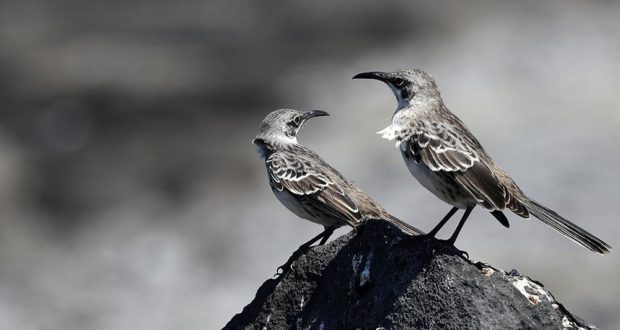My attention was first thoroughly aroused, by comparing together the numerous specimens, shot by myself and several other parties on board, of the mocking-thrushes, when, to my astonishment, I discovered that all those from Charles Island belonged to one species (Mimus trifaciatus); all from Albermarle Island to M. parvulus; and all from James and Chatham Islands belonged to M. melanotis.
– Charles Darwin, Voyage of the Beagle, 1835
Darwin’s finches get all the attention today, but it was the mockingbirds that starting him musing on the diversity of species across the Galapagos Islands.
Darwin collected a lot of finches while he was there, but apparently did not consider them particularly significant at the time. Not only did he forget to note which islands they came from, he didn’t even realize they were all finches. It took a perceptive London ornithologist to recognize much later that among Darwin’s collection of preserved birds were more than a dozen finch species.
While in the Galapagos, however, Darwin identified three distinct species of mocking-thrush, as he called them. He noted that each species, while confined to a particular island, occupied roughly the same ecological niche:
The distribution of the tenants of this archipelago would not be nearly so wonderful, if, for instance, one island had a mocking-thrush, and a second island some other quite distinct genus … But it is the circumstance, that several of the islands possess their own species of the tortoise, mocking-thrush, finches, and numerous plants, these species having the same general habits, occupying analogous situations, and obviously filling the same place in the natural economy of this archipelago, that strikes me with wonder.
Four endemic species of mockingbirds inhabit the Galapagos, and I came across three of them: the Galapagos Mockingbird (Mimus parvulus) on Santa Cruz; the Chatham Mockingbird (M. melanotis) on San Cristobal; and the Hood Mockingbird (M. macdonaldi) on Espanola. The fourth, the Charles Mockingbird (M. trifaciatus), is found only on the small islands of Gardner and Champion.
It is difficult to tell them apart at a glance. From their slender body, grey plumage, long tail and melodious call you would easily recognize them as a relative of the Northern Mockingbird (Mimus polyglottos) common throughout Texas.
The Hood Mockingbird on Espanola is the most distinctive of the group. It is slightly larger than the others, has longer legs and a long black bill with a more pronounced downward curve. I observed a couple of them on the beach, digging out a small vertical hole in the sand, presumably in search of insects or crustaceans. Their bill seemed well suited to the purpose.
The Galapagos Mockingbird is the most common of the group and inhabits every island except those where the other three are resident. I came across several while walking a trail through the thick Palo Santo and Opuntia cactus along the coast of Santa Cruz. Their plumage is darker than the others, and the dark patches on either side of their eyes are more distinct. Although the guidebooks describe their eyes as yellow-green, the ones I saw were much closer to a shade of brown.
The plumage of the Chatham Mockingbird, an exclusive resident of San Cristobal, is intermediate between the other two – not as dark as M. parvulus and not as light as M. macdonaldi. The eyes of the ones I saw were more of a burnt orange. Every M. melanotis I saw foraging was eating small seeds or pecking at crevices in the bark of trees.
To see the three species matched up with their respective islands I’d have to have a handful of specimens from each island laid out on the ground in front of me, which is what I imagine what Darwin did. But once I had the concept of species unique to an island in my head, I’d start looking for the same pattern in other fauna, which is what I imagine Darwin did.


